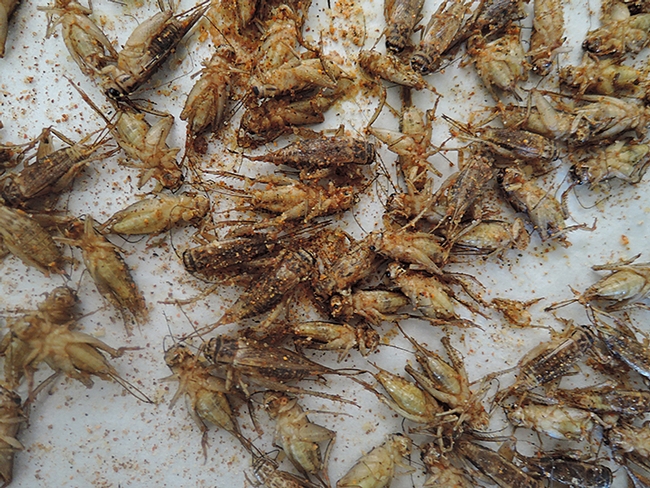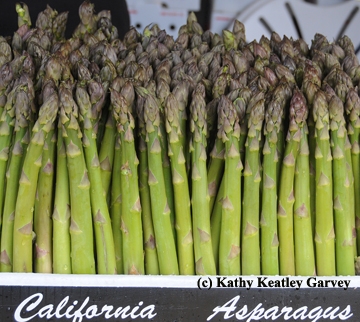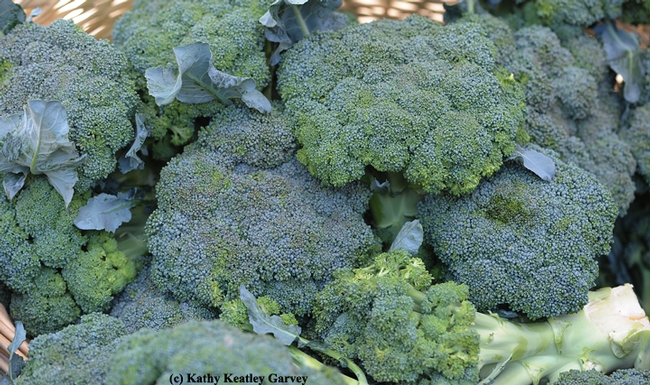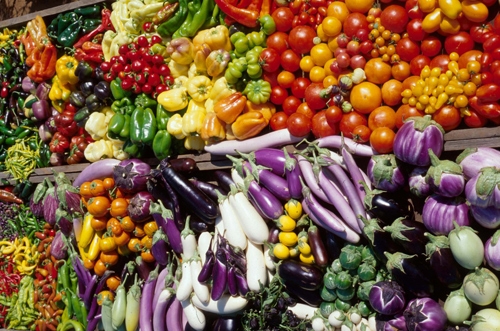
Posts Tagged: Eating
Bohart Museum: The Joy of Eating...Drum Roll...Insects
If you want to know what it's like to eat a bug—doesn't everybody?--ask an entomologist, a bug ambassador, or an entomophagist, one who eats insects. So we did…Because the Bohart Museum of Entomology is hosting an open house on entomophagy from 1 to 4 p.m., Saturday, Sept. 21 in Room...

Make a meal out of mealworms? Danielle Wishon baked these mealworm cookies. Yes, they were good. (Photo by Danielle Wishon)

Crickets will be on the menu at the Bohart Museum of Entomology's open house. Visitors are invited to sample them. Crickets are the new shrimp, says Lynn Kimsey, director of the Bohart Museum. (Photo by Kathy Keatley Garvey)
The Incredible Aphid-Eating Machines
Just call them the "incredible aphid-eating machines." That would be the lady beetles, commonly known as ladybugs (although they are not bugs; they're beetles belonging to the family Coccinellidae, and they're not all "ladies"--some are male!). How many aphids can a lady beetle eat? Scientists...

Lady beetle larva dining on aphids on milkweed, UC Davis campus. (Photo by Kathy Keatley Garvey)

A lady beetle, aka ladybug, tracks down more prey. (Photo by Kathy Keatley Garvey)
UC Davis tomatoes provide year-round healthful eating for college students

At the same time, chefs and food buyers at universities, particularly the University of California, are selecting for high-quality fruits and vegetables, produced locally and sustainably. Universities with strong food sustainability programs are rightfully proud of what they're doing to educate students about food production, health, and nutrition. UC Davis Dining Services prioritizes the purchase of locally grown food (ideally within a 50-mile radius of campus). Most University of California campuses have similar programs.
At UC Davis, fresh roma tomatoes are picked each August from the 300-acre Russell Ranch, part of the campus's Agricultural Sustainability Institute, then processed within hours by campus Dining Services to provide year-round tomato sauce for pizza, pasta, and ratatouille. All told, 10,000 pounds of tomatoes are processed during a two-week period in August. About 29 percent of the total food served in the campus's residential dining halls is from local, organic or sustainable sources.

Emma Torbert, an academic coordinator at the UC Davis Agricultural Sustainability Institute, noted, “Connecting the food system to the research is really interesting. A lot of times there is confusion about where our food is coming from. The more people are educated, the more educated decisions they can make.”
Many UC Davis faculty and staff are so impressed with the food choices at the dorms that they purchase individual meal tickets and enjoy lunches made with the campus-grown tomatoes, herbs, and other vegetables, all of which are part of the daily food array. Public dinners are also offered periodically at the dorms so that community members can sit amongst students to taste and learn about the sustainability programs in the dorms.
Additional Information:
- Video: Farm to Table, UC Davis Tomatoes; 2010
- Slide show of this year's UC Davis tomato harvesting and processing system; 2014
- Sustainable Foodservice Progress Report 2014, UC Davis Dining Services
- Two videos of UC Davis students who work at the Student Farm to produce food, including one on tomato sauce production
- “Tomatoes: Safe methods to store, preserve, and enjoy.” UC Agriculture and Natural Resources, free publication
The joy of eating green: Ten things you should know about saving money and eating healthier

You're famished. The potato chips look good. The glazed doughnuts look even better. And that chocolate candy bar? To die for.
Bring ‘em on!
No, wait a minute. Let's get real, let's get green and let's get healthy. And let's save some money.
Nutritionist Amy Block Joy, Cooperative Extension specialist emeritus, teaches a University of California, Davis, freshman class on “Eating Green” and we asked her for the 10 best ways to save money and eat healthier.
Joy, who holds a doctorate in nutritional sciences from UC Berkeley, specializes in nutrition and health disparities of diverse populations and nutritional ecology, as well as workplace ethics.
Her advice needs to be posted on every refrigerator in the country. (Along with that shopping list!)
- Shop with a list: Using a list will keep you focused on meal planning and reduce the temptation to buy unneeded items.
- Don't shop when you're hungry: Temptation is high when you're hungry. Eat first and you'll be less inclined to spend extra dollars on those food items placed near the check-out stand that are high in calories and fat and low in nutrition. That would be snacks! Try shopping after a meal and you will find yourself less tempted by those chocolate-covered pretzels!
- Read the nutrition facts label: When shopping for the healthiest foods, you should read the nutrition fact labels to check out fat, calories, fiber, carbohydrates and sodium. Aim for low-fat, high-fiber foods that have essential vitamins and minerals. For example, if you want the best source of fiber - buy fresh oranges and eat them raw rather than selecting orange juice. However, if you want juice, be sure that you are getting real juice. And, some juices are now fortified with calcium - a big plus for increasing your calcium intake if you are not drinking milk.
 Please don't pass by the peas. (Photo by Kathy Keatley Garvey)
Please don't pass by the peas. (Photo by Kathy Keatley Garvey) - Read the ingredient lists: The ingredient list will provide important clues on products that you'll want to include in your diet. One of them is to look for whole grains. The information on the product may make you think the product is "natural" but what does that really mean? Not much because the phrase you want to look for is the "USDA organic" label. With so many choices of breads these days, you'll want to find ones that have whole grains and fiber. Find the information by reading the label (compare fiber amounts) and ingredients (look for "whole" grains).
- Compare prices: Supermarkets provide price-comparison information located by their products. You can compare the "unit" costs so that you'll be able to determine the lowest cost of the product. Two words of caution: products "on sale" may not be the best bargains.
 Asparagus is part of going green. There's also a white variety now. (Photo by Kathy Keatley Garvey)
Asparagus is part of going green. There's also a white variety now. (Photo by Kathy Keatley Garvey) - Shop the perimeter of the store: Marketing experts have placed the healthiest foods at the farthest corners of the store so that the shopper has to stroll through the other items before finding fruits and vegetables, protein sources (poultry, meats), dairy products and cereal products.
- Think protein: Buy meat and poultry on sale and use these foods to make stews, soups and chili. This way you can stretch these more expensive food sources. Beans are a great source of protein and are low fat and high in fiber.
- Plan meals ahead: The best way to save money is to plan your meals in advance. Buying unprocessed foods will improve your health and also save money. It costs to add preservatives, food additives and packaging of products that you, the consumer, are paying for. It's much cheaper to buy rice in bulk rather than already prepared rice products. Brown rice contains more fiber than white rice.
- Cook! Your grandmother was right. Food prepared from scratch will taste better, be healthier and save money. Research has shown that cooking not only saves money but improves nutrition.
- Enjoy! Food is meant to be a pleasant happy experience. Don't forget to enjoy it!
So, the next time you're racing out the door on your way to the supermarket, be sure to eat first so you're not tempted by foods that you know aren't good for you.
And that shopping list? You can also key that in on your cell phone so neither the list, nor your phone, will get left behind.
Meanwhile, we all ought to follow Amy Block Joy's great advice on saving money, eating green, and being healthier.
As I wrote on one of my college essays, "We have a choice in the matter and it matters that we have a choice."

The produce aisle is a good place to "go green and eat healthier." (Photo by Kathy Keatley Garvey)

Grocery stores usually place fruits and vegetables around the perimeter. (Photo by Kathy Keatley Garvey)

Broccoli--a food everyone should love. (Photo by Kathy Keatley Garvey)
Choosing healthy foods might be easier than you think
Doctors say we'll live longer if we exercise and eat right. Okay, but what does that mean, exactly? You hear so much about super foods and super diets that knowing how to “eat right” can be super confusing.

“This isn't about starving yourself or biting off more than you can chew at the gym,” Applegate says. “It's about making good-for-your-body decisions, rather than punishing you with cutting calories and tough-to-do workouts.”
Applegate teaches nutrition at UC Davis, including a wildly popular online and in-person nutrition course that attracts several thousand students each year. She's a triathlete, a sports nutrition columnist for Runner's World, an author of several sports nutrition books, director of sports nutrition for Intercollegiate Athletics at UC Davis, and a consultant for Olympic athletes.
In short, she knows her stuff. And when it comes to healthy eating, she says, don't over-think it.
“Eating well isn't about being perfect, but about finding out what food has to offer, and striking a balance between your needs, personal preferences, culture and family experience,” she says.
That philosophy is central to her healthy eating and exercise challenge, which you can pick up at any Nugget Market or download from its website here. Applegate's shopping list includes a wide variety of tasty foods — a bounty of fresh vegetables, various meats and poultry, fish, eggs, grains, dairy, chocolate and much more. What's not to like?

- Eat breakfast. A solid morning meal sets the stage for a good day of healthy eating.
- Eat some protein at every meal to manage weight and support your exercise.
- Whole grains like brown rice, quinoa and whole wheat are your friends (unless you cannot tolerate gluten. If so, stick with brown rice and other non-wheat products).
- Aim for at least 2½ cups of veggies and 2 to 3 pieces of fruit each day.
- Include healthy fats from fish, nuts and seeds. Use olive, canola or avocado oils.
- Aim for 2 to 3 servings of calcium-rich foods like dairy or soymilk. Each day, eat a probiotic such as yogurt or kefir for digestive and immune support.
As for fitness, the plan provides a do-at-home circuit of strength training exercises, such as planks, push-ups, squats and leg lifts. Her general rules are:
- Switch things up. You'll build stronger muscles when you try different types of exercises.
- Aim for 30 to 60 minutes of moderate to vigorous activity five to seven days a week. Anything that boosts your heart rate counts — fast walking, jogging, bike riding, swimming, dancing, basketball, you name it. If you can't find time for 30 minutes straight, 10 minutes here and there will do the trick.
- Include three to five do-at-home strength-building sessions that help shape and tone major muscle groups while building core strength.
Adjusting to healthy eating and routine exercise takes time, Applegate says, so don't be too hard on yourself.
The joy is in the journey.


